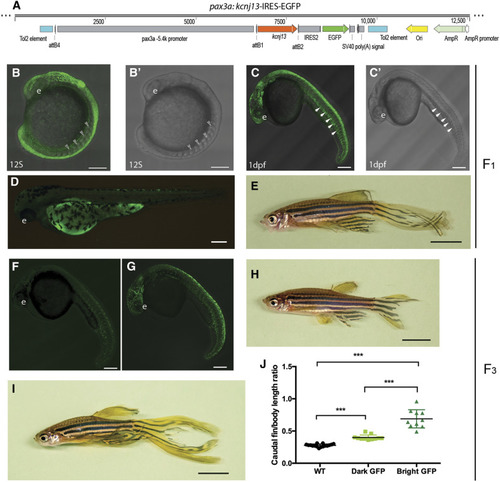
Transient ectopic expression of kcnj13 by pax3a promoter phenocopies Dhi2059 elongated fins. (A) Schematic illustration of a construct (pax3a:kcnj13-IRES-EGFP) used for Tol2 transgenesis. A 5.4-kbp-long pax3a promoter drives kcnj13 and independent EGFP expression. (B–E) Representatives of F1 generation of pax3a:kcnj13-IRES-EGFP transgenic fish. (B) EGFP expressed in the somites of a 12S-stage fish embryo. White arrowheads indicate the somites. (B’) Bright-field image of the same embryos in (B). (C) EGFP expressed in the somites and dermomyotome of a 24-hpf-stage fish embryo. White arrows indicated the dermomyotome. (C’) Bright-field image of the same embryos in (C). (D) EGFP expression disappears from somites in a 48-hpf-stage zebrafish embryo. Only autofluorescence is visible. (E) Representative gross morphology of an adult Tg(pax3a:kcnj13-IRES-EGFP). Elongation of the fins is similar to the Dhi2059 mutant. (F–I) Representatives of F3 generation of pax3a:kcnj13-IRES-EGFP transgenic fish. (F). A dark-EGFP fish embryo. (G) A bright-EGFP fish embryo. (H) An adult dark-EGFP transgenic fish. The fin is slightly elongated compared to WT. (I) An adult bright-EGFP transgenic fish. (J) Comparison of the ratio of caudal fin over standard body length among no-EGFP (n = 16), dark-EGFP (n = 11), and bright-EGFP (n = 10) adult transgenic fish. *) P < 0.0001 by pairwise Student’s t-test. Bars, 200 μm (B–D, F, and G), Bars, 5 mm (E, H, and I). 12S, 12-somite; e, eye; EGFP, enhanced GFP; IRES, internal ribosome entry site; WT, wild-type.
|

